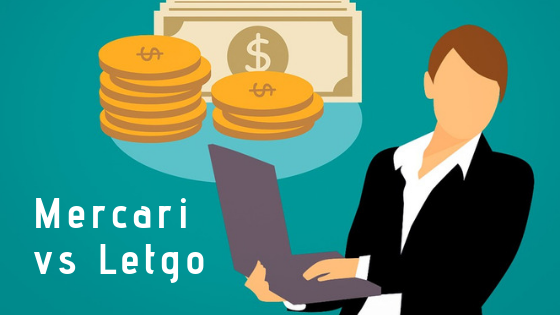If you have stuff to sell and want to sell it as quick as possible and make as much money as possible, then you need to know which platform to use. There are loads of different secondary selling platforms out there and they are not all created equally.
In this article we’ll be specifically looking at Mercari vs Letgo.
Should you sell that old Ralph Lauren sweeter that could fetch you a pretty penny on Mercari? Should you sell your tredmill that you no longer use on Letgo? Does it even matter?
Yes, it definitely does matter–if you want the best results.
Let’s find out how these two platforms compare and which you should be using…
Overview
You’ve probably heard the comparison before but I’m going to say it here too because it works great: Mercari is to Ebay what Letgo is to Craigslist.
- Mercari – a new hip Ebay-like platform that makes it easy to sell things nation-wide
- Letgo – a new hip Craigslist-like platform that makes it easy to sell things in your local area
Both of these platforms provide a more enjoyable experience than than Ebay or Craigslist, and both are excellent alternatives that make a lot of the selling process more smooth and simple because you can easily do everything on your phone with their apps.
In a nutshell, Mercari is like a newer Ebay and gives you the ability to sell items to buyers all across the country–who will pay you through the platform and who you will have to ship to, whereas Letgo is like a newer Craigslist and gives you the ability to easily sell items to local buyers–which will pay you directly and pick up the item themselves.
Using The Platforms
Let’s start by taking a look inside the two apps. Below is a screenshot–Mercari on the left and Letgo on the right…

Mercari
Mercari has a very Ebay-like feel to it, which makes perfect sense since it pretty much is a newer version of Ebay in a sense. It has a lot more going on with it–a lot of different categories you can buy/sell in and users can even shop by brand.
When selling an item you will begin by taking a picture on your phone through the app. Then you will fill in some basic information such as the category the item falls into, the brand, condition, add a brief description, set a price, state where you will be shipping it from and so on.
Example: Below I took a quick picture of a laptop of mine and that’s it. What’s great about the app is that it automatically fills in as many details as possible using AI. It recognized my item as an HP laptop and filled that information in on it’s own.
 After listing an item for sale the process is pretty simple–buyers will be able to purchase your item through the platform at the price listed or make you an offer, which you can accept or reject.
After listing an item for sale the process is pretty simple–buyers will be able to purchase your item through the platform at the price listed or make you an offer, which you can accept or reject.
The money is all handled over the platform–and if someone asks to send you a check in the mail or something of this nature, it is highly recommended that you do not accept this form of payment–keep the entire transaction on the platform for your safety.
Upsides
- Easy to use
- Payments are handled through the app for safety and convenience
- Large nation-wide audience
- Faster than normal selling–uses AI ot match buyers and sellers
Downsides
- Shipping can be a pain
- Sellers fees–10% after you make a sale!
Letgo
Letgo is a much more basic app, just as Craigslist is much more basic than Ebay. Here you do much of the same thing, just you don’t deal with shipping and most sellers don’t provide as much detail in their listings.
Example: Below I took another picture of my laptop, this time using Letgo. This app also uses AI to fill in details for you with what you are selling. As you can see, it recognized it as a laptop, automatically put it into the category of Electronics, and even set a price for me of $100–which there is no way I would sell it for this little, but you can easily change this.

With the example shown above the app didn’t fill in all that many details for me, but I have had better experiences with other items–it just depends on what you are selling. For example, at one point I sold a set of matching luggage bags on the app–and when doing this all I did was snapped a picture. It then added it’s own description which was good enough for me–so literally all I did was took a picture and clicked “post”.
After posting your item buyers will be able to easily contact you. Then you will arrange to meetup and make the transaction face to face, no shipping involved–although you could ship your item if you somehow worked this out with the buyer (not recommended).
*Everything is free, but they do have an option where you can pay to have your listings get more exposure–which will help them sell faster.
Upsides
- 100% free (can pay for more exposure, but don’t have to)
- Easy to use
- Prewriten messages for fast and easy communication
- Faster selling than normal–AI matches buyers and sellers
- No dealing with shipping
Downsides
- No payment process–transaction is completely up to seller and buyer
- Only local buyer market
There is no doubt that both apps are mardern marvels of the secondhand marketplace, but which is a better choice for you? Let’s dive into it…
Where to Sell Your Stuff – Mercari or Letgo?
- Ralph Lauren sweater – Mercari
- Pair of shoes – Mercari
- TV Stand – Letgo
- Old refridgerator – Letgo
- Old car – Letgo
- Couch – Letgo
- School textbook – Mercari
It is fairly obvious with these examples which platform you should use to sell your stuff. As a general rule of thumb, most people will sell the bigger items that will be a hassle to ship on Letgo and the smaller items on Mercari, but it’s not always so cut and dry.
For example, let’s say you have a used laptop computer that you want to sell. Mercari may seem like the better choice because this would be an easy item to ship, but don’t jump to conclusions too fast. Used laptops are an item that are in very high demand and even if you try selling it locally, you will have people that are interested (as long as the laptop isn’t ridiculously old).
I personally have had great success selling laptops on Letgo–and am glad I gave it a try because I didn’t have to think about shipping.
Other small items that might be easily sold on Letgo include smartphones, tablets, and other electronic devices.
On the other hand, you may get better results posting somewhat large items on Mercari if they are very unique and lack a large market of buyers–for example a GI Joe themed computer desk might be a hard sell in your local area with Letgo.
When you don’t know where to post your items–just post them on both platforms.
Safety
Safety is always a concern.
Which of these platforms is your safest bet?
Is a buyer on Letgo going to scam you, maybe by paying with conterfiet money?
Is someone on Mercari going to lie and say that the item you shipped was damaged and demand a refund?
These are both serious concerns–after all we are trying to make money with these platforms, not waste our time.
By selling on Mercari the main concern is that you are going to ship out your item and the buyer is either going to say that it was damaged. Then you have either the option to pay for return shipping, which might not be worth it since the item could be damaged, or just let them keep it and give them a refund–all the while taking their word on the matter. Mercari will help mediate disputes, but as is the case with pretty much any platform of this kind, they will favor the buyer most of the time.
On Letgo the main concern is that you might be ripped off with conterfeit money or may even be mugged. This is why the app suggests meeting in a public area. As for the conterfeit money–I wouldn’t be too concerned–and you can always get a conterfeit marker if you are.
With both platforms there are some concerns that are unavoidable–just as any secondary selling platform out there. Unfortunately if a buyer really wanted to scam you, they probably could. Fortunately most buyers aren’t scammers and I have never encountered such personally.
Recap
- Both platforms have convenient apps for quick and easy selling
- Letgo is free, Mercari takes a 10% fee from your sale
- Letgo is for selling locally, Mercari is for selling nationwide
- With Letgo you handle payments directly with buyers, whereas with Mercari the payments are made through the platform
- Letgo is usually better for selling bigger items that you wouldn’t want to ship, whereas Mercari is often better for small things–although this isn’t always the case
And The Winner Is…
There is no winner. The fact of the matter is that Mercari and Letgo are similar yet very different, and because of this we can’t really do a straight comparison.
They both have their upsides and downsides and they are both great platforms for selling.
If I absolutely had to pick one–if it was a life or death situation–I would go with Letgo just because it is more simple and there aren’t any fees–and most items will probably sell on their anyhow.
I hope you enjoyed the comparison.
What do you think? Have you had good experiences with either platform? What would be your first choice? Let us know in the comment section below 🙂


